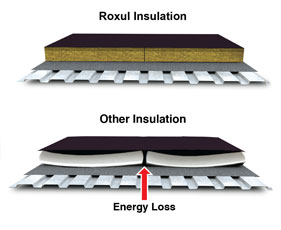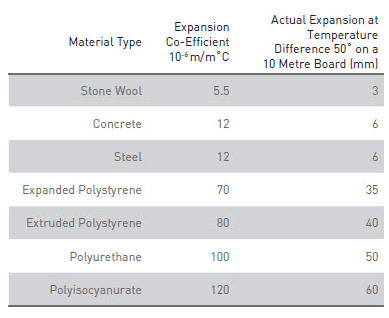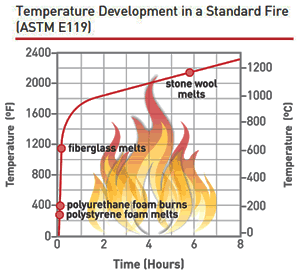Stone Wool Insulation - Improving Building Performance
 |
Stone wool is manufactured from natural volcanic basalt rock and recycled slag. Image courtesy of Roxul Inc. |
The dimensional stability of an insulation material is necessary for the faultless function of an insulation system. Dimensional changes in materials vary according to their physical properties. Thermal expansion co-efficients express the rate at which materials shrink or expand when cooled or heated. Stone wool insulation has a much smaller thermal expansion coefficient than organic insulation materials such as foam plastics. Poor dimensional stability can cause shrinking, expansion, and buckling of a system's insulation. These actions can lead to thermal bridging, waterproofing breaches, and unpredictable insulation performance.
The most common dimensional change in building materials is created by temperature variation. In thermal insulation, the rate of this dimensional change due to temperature variation is based on 3 factors: the difference in temperature (∆T), the coefficient of linear expansion (α), and the specimen length (l). Using these variables, the table in Figure 2 illustrates the dramatically reduced movement of stone wool insulation at a temperature difference of 50 degrees for a 10 meter board compared to the same sized common organic plastic insulation boards. Stone wool is also much closer to the coefficient of expansion of steel and concrete than the plastics meaning that it will move more closely in line with those materials.
 |
A comparison of expansion rates of different building and insulation materials Image courtesy of Roxul Inc. |
The other common dimensional change in many insulation products occurs due to aging. The molecular structure of foam insulation is initially unstable for a period of time after manufacturing and so there is high potential for shrinkage to occur. As this shrinkage is deemed to be an "acceptable practice" within the roofing industry, ASTM D2126 Test Method for Response of Rigid Cellular Plastics to Thermal and Humid Aging allows for a maximum shrinkage of 2% (length and width). In theory, this will reduce the insulation footprint covering a roof deck for example by 2%, thus allowing for increased heat loss and leaving the roofing membrane unsupported along insulation joints thus increasing the potential for damage. By contrast, studies have proven that stone wool insulation maintains its dimensions and its physical characteristics throughout a building's life cycle. By maintaining the material's original dimensions, full thermal insulation coverage is maintained and the roofing membrane service life is extended due to a lack of unnecessary stress and or fatigue.
Fire Resistance
Fire resistance describes how well a building component can - for a stated period of time - hold back fire and prevent it from penetrating from one room to another. The basic criteria used to characterize the fire resistance of a product are flame spread, smoke development and non-combustibility. Because of its stone and slag makeup, stone wool excels in all three of these criteria. Stone wool insulation is typically classified as "non-combustible" as determined by ASTM E136 and CAN4-S114. It will not develop toxic smoke or promote flame spread, even when directly exposed to fire, as most other insulation materials do. When tested in accordance with ASTM E 84 results typically show a flame spread of 0 and a smoke development of 0 to 5. By comparison, spray polyurethane foam [SPUF] tested to ASTM E 84, typically achieves a flame spread of 25 and smoke developed in the 350 to 500 range.
Beyond these basic fire resistance properties, stone wool insulation has an impressive ability to withstand temperatures up to its melting point of approximately 2150° F (1177° C). As such, it can act as a fire barrier,when used in conjunction with appropriate fire sealant materials,thus protecting against the spread of fire and providing valuable extra minutes to save people and property. This is quite a contrast to most other insulation materials and even many other building materials. This has been illustrated recently in 2010 fire in Shanghai, China which raised new concerns about fire safety during construction. In the case of the Shanghai fire, foam insulation was ignited accidentally during construction and quickly spread through the building exterior. Because of these safety concerns, architects should take into account the added value that the passive fire resistance that stone wool provides for buildings.
 |
A comparison of different fire resistance properties of insulation products. Image courtesy of Roxul Inc. |
Since stone wool insulation does not contribute to fire it can provide additional minutes of protection for occupants to reach safety. It can also provide fire services personnel valuable time to both clear occupants, and control the spread of fire while delaying the collapse of various structural members of the building. Again by contrast, foam plastic insulation is regulated by chapter 26 of the International Building Code (2009) stating that it must meet ASTM E84 ratings of a flame spread of 75 and smoke development of 450. Even at those levels, it must also be separated from the building interior by an approved thermal barrier (which does not apply to stone wool.) However, this protection barrier shielding the plastic foam from the interior does not take away the "stored" fuel of the foam plastic that could supply energy to a fire contributing to the heat of combustion. Finally, medical journals have shown that smoke inhalation accounts for an estimated 50 to 80 percent of deaths in a fire. Smoke inhalation occurs when an occupant inhales chemicals of combustion during a fire. Smoke is generated by a product's combustion and is a mixture of heated gases and particles. To reduce the potential for smoke inhalation in buildings, specifying non-combustible products, such as stone wool, is highly recommended.









